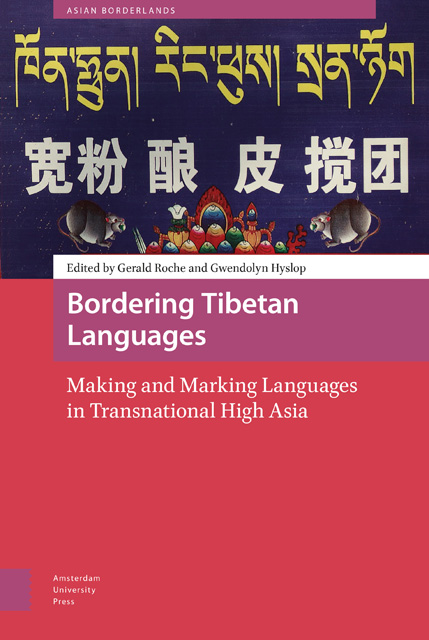Book contents
- Frontmatter
- Table of Contents
- Acknowledgements
- About the Cover Image
- 1 Introduction: Bordering Tibetan Languages: Making and Marking Languages in Transnational High Asia
- 2 Playing with Language Boundaries: Heteroglot Standard Language Ideology and Linguistic Belonging among Amdo Children
- 3 The Role of Classical Tibetan (Chöke) on the Development of Kurtöp, a Language of Bhutan
- 4 Reimagining Rongring without Tibetan Buddhist Influence
- 5 Glottonyms, Identity, and Language Recognition in the Eastern Tibetosphere
- 6 On the Yak Horns of a Dilemma: Diverging Standards in Diaspora Tibetan
- 7 Changing Identity and Linguistic Practices in Nubri: Veiled Language Endangerment in the Nepalese Tibetosphere
- 8 Borderline Dominance: Transnational Tibetan Language Politics in the Himalayas
- 9 Borders: In Conclusion
- Tibetan Language Summaries
- Asian Borderlands
- Index
9 - Borders: In Conclusion
Published online by Cambridge University Press: 24 November 2022
- Frontmatter
- Table of Contents
- Acknowledgements
- About the Cover Image
- 1 Introduction: Bordering Tibetan Languages: Making and Marking Languages in Transnational High Asia
- 2 Playing with Language Boundaries: Heteroglot Standard Language Ideology and Linguistic Belonging among Amdo Children
- 3 The Role of Classical Tibetan (Chöke) on the Development of Kurtöp, a Language of Bhutan
- 4 Reimagining Rongring without Tibetan Buddhist Influence
- 5 Glottonyms, Identity, and Language Recognition in the Eastern Tibetosphere
- 6 On the Yak Horns of a Dilemma: Diverging Standards in Diaspora Tibetan
- 7 Changing Identity and Linguistic Practices in Nubri: Veiled Language Endangerment in the Nepalese Tibetosphere
- 8 Borderline Dominance: Transnational Tibetan Language Politics in the Himalayas
- 9 Borders: In Conclusion
- Tibetan Language Summaries
- Asian Borderlands
- Index
Summary
Abstract
Like the Berlin Wall, borders have been known to inculcate pain and suffering, potentially trickling down across generations. Some borders are less salient, and their effects less obvious, but they are notable catalysts of change nonetheless. This final chapter summarizes how religion, education, names, and literacy have featured as bordering forces in shaping language and language change across the greater Tibetan Plateau.
Keywords: historical linguistics, Tibeto-Burman languages, Buddhism, education, literacy, nomenclature
This final chapter was initially drafted in Berlin, at the onset of the COVID-19 pandemic. International borders were suddenly sealed shut out of the fear that COVID-infected passengers could bring the novel coronavirus into countries where the disease had not yet reached. When this book was finalised, Australia's borders were still closed, keeping families ripped apart indefinitely. While one can understand some of the drivers behind the compulsion to create and maintain borders, we can also learn from the history of the Berlin Wall about what effect borders have on those whose lives are shaped by them. The borders discussed in this book, though not always as prominent as the Berlin Wall, or as cruel as the Australian travel ban, are nonetheless influential in shaping the lives of the people whose linguistic ecologies are described in this book.
Historical linguistics has tended to focus on the change and development of linguistic structures over time, either via the ‘tree’ model (e.g. Schleicher, 1853) or the ‘wave’ model (e.g. Schmidt, 1872). The focus has largely been on the linguistic structures themselves, and not the sociocultural context in which the languages change and develop. This book has examined several languages in their social, cultural, and political contexts. The chapters comprising this volume have outlined case studies, showing how language is used and has developed in complex multilingual environments in the Greater Tibetan region. We find four themes, in particular, that resonate throughout the stories told in these chapters. These themes are religion, education, names, and literacy. I conclude that we may want to incorporate these themes back into our historical linguistic model, that these themes can stand in as bordering forces shaping the sociohistorical context that is so relevant to language and language change.
- Type
- Chapter
- Information
- Bordering Tibetan LanguagesMaking and Marking Languages in Transnational High Asia, pp. 197 - 202Publisher: Amsterdam University PressPrint publication year: 2022



